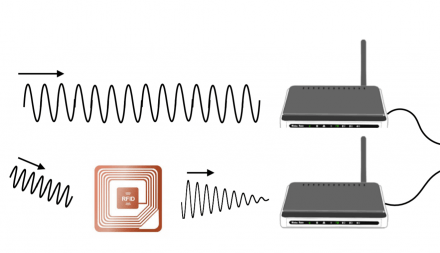Small, energy efficient radio for IoT rides along on WiFi
December 14, 2016
on
on

The Internet of Things frequently makes use of wireless connections such as WiFi. For many (sensor) applications it would be very convenient if this connection didn't use a lot of energy. This is the targeted application for the HitchHike.
A research team from Stanford University had the idea for the HitchHike, an ultra-low-energy wireless radio module that is nearly ideal for low-energy IoT applications. The HitchHike needs only a few microwatts to transmit data autonomously. But it can also be integrated in an existing WiFi environement with, for example, a smartphone or a standard WiFi router.
The current prototype is the size of a postage stamp and 'surfs', as it were, along on existing radio waves. An existing signal is received, the data of which is compared with the data that is to be transmitted. The difference of this data (a '1' when the data to be transmitted was a '0') results in an alternative message which is sent on a different WiFi channel. For all this the HitchHike uses 10,000 times less energy than current WiFi modules. A small battery would be good for 10 years or more, according to the researchers.
It is expected that it will be another 3 to 5 years before the modules becomes available commercially.
More information: http://news.stanford.edu/press-releases/2016/11/16/miniature-wifi-d-internet-things/.
Photo Credit: InternetOfBusiness.com
A research team from Stanford University had the idea for the HitchHike, an ultra-low-energy wireless radio module that is nearly ideal for low-energy IoT applications. The HitchHike needs only a few microwatts to transmit data autonomously. But it can also be integrated in an existing WiFi environement with, for example, a smartphone or a standard WiFi router.
The current prototype is the size of a postage stamp and 'surfs', as it were, along on existing radio waves. An existing signal is received, the data of which is compared with the data that is to be transmitted. The difference of this data (a '1' when the data to be transmitted was a '0') results in an alternative message which is sent on a different WiFi channel. For all this the HitchHike uses 10,000 times less energy than current WiFi modules. A small battery would be good for 10 years or more, according to the researchers.
It is expected that it will be another 3 to 5 years before the modules becomes available commercially.
More information: http://news.stanford.edu/press-releases/2016/11/16/miniature-wifi-d-internet-things/.
Photo Credit: InternetOfBusiness.com
Read full article
Hide full article



Discussion (0 comments)